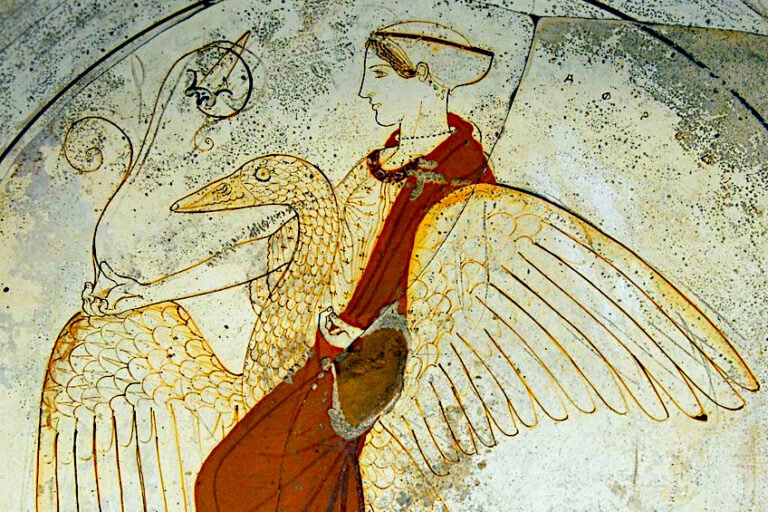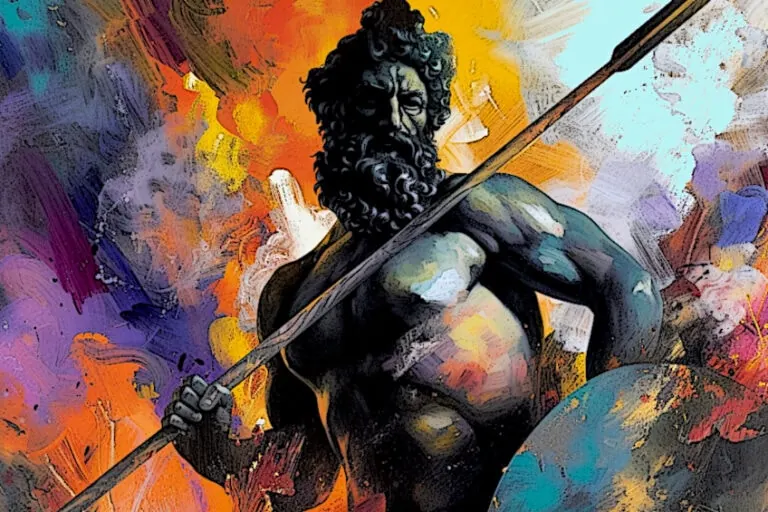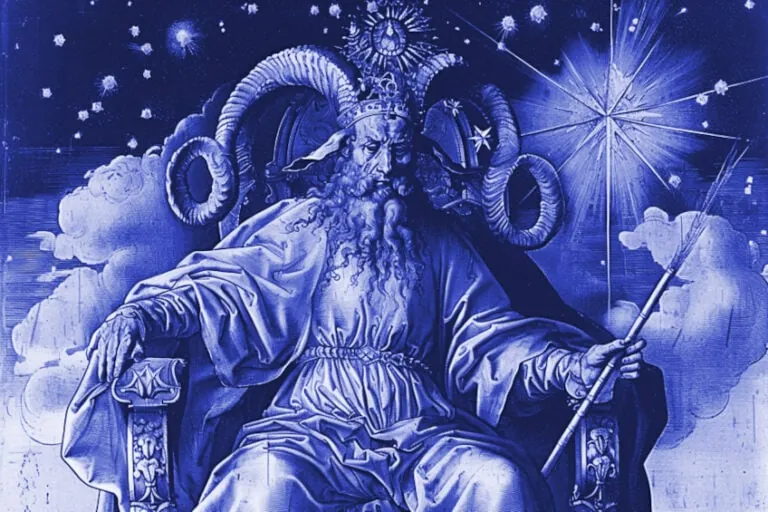Greek Goddess Iris – The Divine Rainbow Messenger
The Greek goddess Iris is regarded as one of the gods’ two messengers, along with the god Hermes, as well as the personification of the rainbow. According to Greek mythology, Iris was the offspring of Electra and Thaumus. The symbols of the winged goddess Iris include the pitcher, the caduceus, and the rainbow. Today’s article will explore the role and significance of this goddess, as well as delve into Iris’ Greek mythology.
The Story of the Greek Goddess Iris
| Name | Iris |
| Gender | Female |
| Symbols | Rainbow, caduceus, and pitcher |
| Personality | Natural leader, focused, and oriented on achievement |
| Domains | Communication, messages, and rainbows |
| Parents | Thaumus and Electra |
| Spouse | Zephyrus |
| Children | Pothos |
The Greek goddess Iris features in various myths of other deities, conveying messages from and to the Olympians or performing errands for them, but she does not have her own mythology. There is little to no evidence of historical Iris worship in existing sources, with only a few remnants remaining on the island of Delos. Iris is represented in ancient Greek art as a youthful winged female holding a pitcher of water from the river Styx for the gods’ libations when they swear oaths, and the messengers’ symbol, the caduceus.
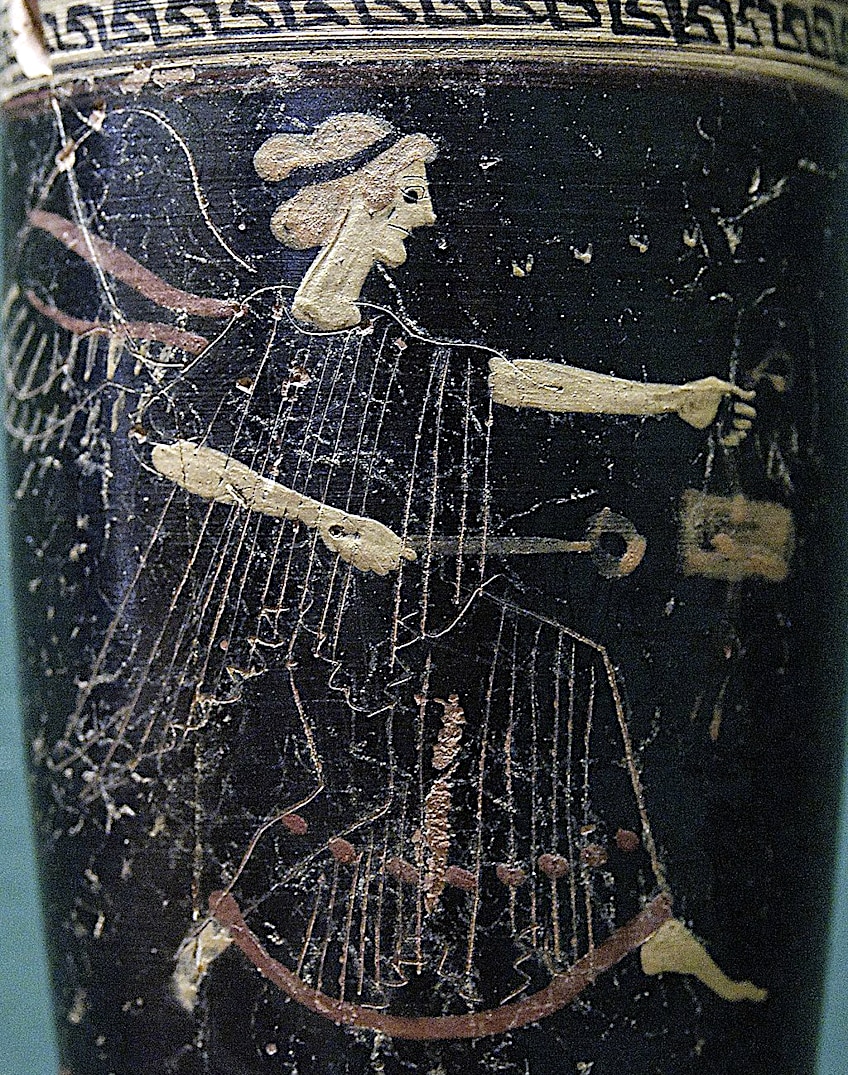 Attic lekysthos with a depiction of Iris in Six’s technique (c. 500-490 BCE); Louvre Museum, CC BY 3.0, via Wikimedia Commons
Attic lekysthos with a depiction of Iris in Six’s technique (c. 500-490 BCE); Louvre Museum, CC BY 3.0, via Wikimedia Commons
Family and Background
In ancient Greece, the word Iris was a reference to both the moon’s halo and a rainbow. In Iris’ Greek mythology, she was said to be the child of Thaumus and Electra, and her consort was believed to be Zephyrus. Their single offspring was Pothos.
Family
Iris’ father Thaumas is a minor Titan god linked with the sea’s wonders. He is often considered to be the son of Gaia and Pontus. Thaumas, as a Titan, is a descendant of the celestial beings who preceded the renowned Olympian gods. Iris’ mother Electra was one of the Pleiades. In Greek mythology, the Pleiades were a family of seven sisters who were the offspring of Atlas and Pleione.
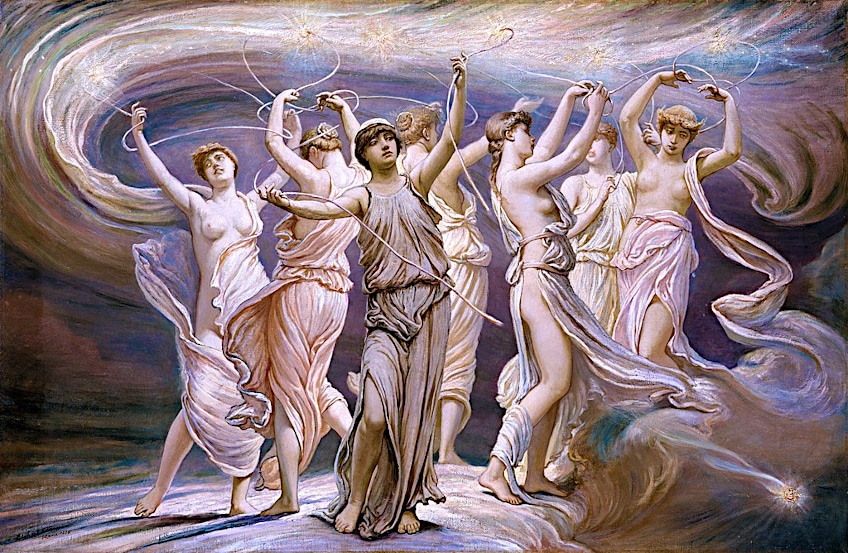 The Pleiades by Elihu Vedder (1885); Elihu Vedder, Public domain, via Wikimedia Commons
The Pleiades by Elihu Vedder (1885); Elihu Vedder, Public domain, via Wikimedia Commons
According to legend, Zeus changed Electra and her sisters into a constellation of stars to protect them from the powerful hunter Orion. The Harpies were Greek legendary beings that were represented as winged spirits or hideous birds with female features.
The Harpies were thought to be the children of Thaumas and Electra, making them Iris’s siblings.
The Harpies were usually represented as agents of retribution or bearers of bad omens. They were connected with the destructive force of storms, executing the will of the gods and occasionally torturing or taking people away.
Consort
The Greek deity of the west wind is Zephyrus, Iris’s husband. He serves as one of the four wind gods, and he represents the calm and beneficial breeze that ushers in the spring season.
Zephyrus is generally represented as an attractive young man with wings and is usually associated with the onset of spring and the emergence of flowers.
Zephyrus is important in mythology as the companion of various divinities. Despite the fact that Zephyrus and Boreas are the two most notable wind gods, their roles in mythology are very limited.
Offspring
The offspring of Zephyrus and Iris was Pothos, the embodiment of desire and intense yearning. He symbolizes the immense emotions and powerful passions that can totally consume people.
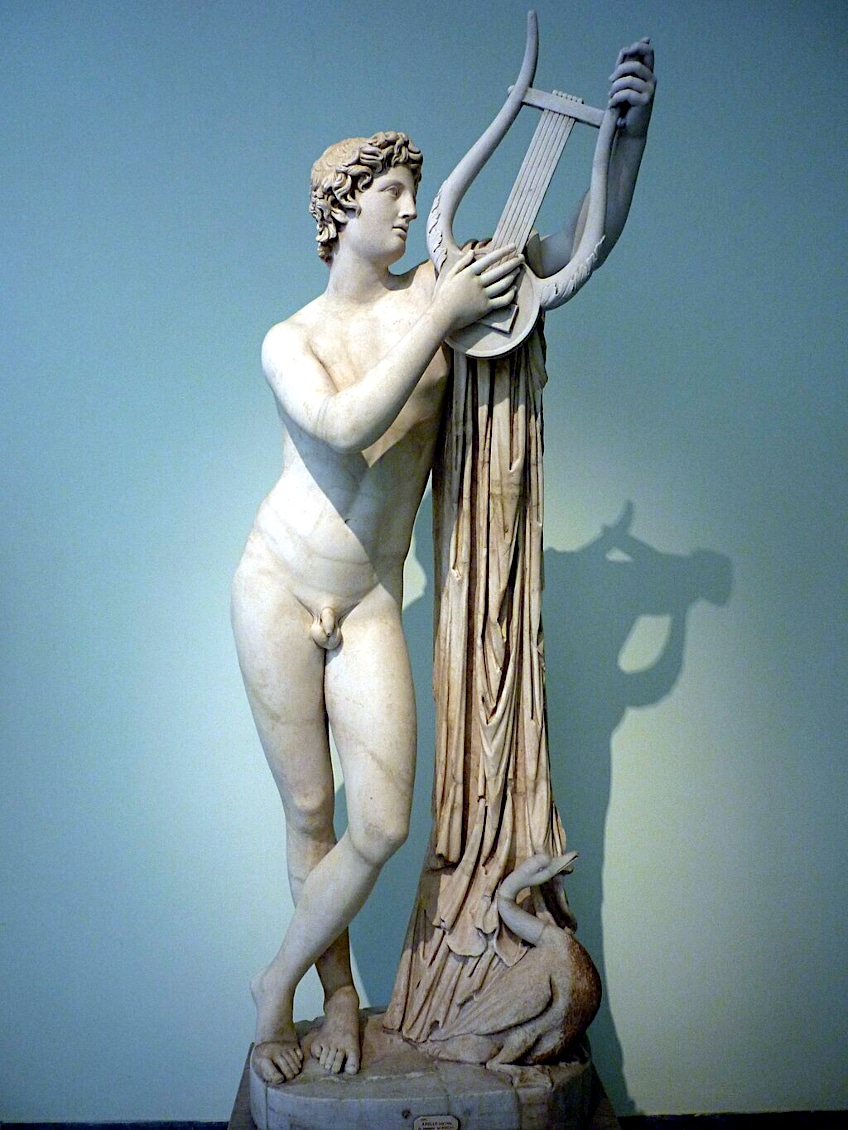 Roman copy of a 4th Century BCE Greek statue of Pothos (2nd-Century CE); Urban, Public domain, via Wikimedia Commons
Roman copy of a 4th Century BCE Greek statue of Pothos (2nd-Century CE); Urban, Public domain, via Wikimedia Commons
Pothos is portrayed as a supernatural character who promotes love and desire, especially in intimate relationships, and was said to have had a role in the marriage of the human hero Peleus and the sea goddess Thetis. In some versions of his mythology, he is regarded as a companion of Eros.
The Role of Iris
The Greek goddess Iris was primarily recognized as the gods’ messenger. She was in charge of transporting mortal petitions and gifts to the skies, as well as delivering significant messages, decisions, and orders from the gods to mankind. Iris served as a conduit for communication and connection between the celestial and ordinary realms. Iris had extraordinary agility and speed, allowing her to travel quickly between Olympus and Earth. She was said to have golden wings on her shoulders, which enabled her to travel long distances in a matter of seconds.
Iris was the embodiment of the rainbow, with its bright arc sweeping the sky. The rainbow was thought to represent a celestial passage or bridge that Iris utilized to make her way to Earth.
Her presence, together with the emergence of a rainbow, was seen as a sign of an important message from the gods or the impending visit of a deity. Iris was not simply a messenger, but also the gods’ herald. She would notify the arrival or presence of deities, especially when divine assistance or intervention was necessary. As a herald, Iris’ relationship to divine power and the proclamation of divine will was emphasized. Other gods and goddesses might occasionally summon Iris to help them with their tasks.
 Copy of a Greek vase painting depicting Zeus and his messengers Hermes and Iris by François Lenormant (1875); FRANÇOIS LENORMANT, Public domain, via Wikimedia Commons
Copy of a Greek vase painting depicting Zeus and his messengers Hermes and Iris by François Lenormant (1875); FRANÇOIS LENORMANT, Public domain, via Wikimedia Commons
She helped Hera, the queen of the gods, fetch water from the River Styx, which was used to bind vows. Iris’ support of other deities demonstrated her adaptability and helpfulness. According to Hesiod, when the deities wanted to swear a binding oath, they would simultaneously touch the waters of the Styx and the Earth’s surface while summoning Zeus’ to bear witness. The River Styx was thought to be a holy and potent river that ran through the underworld, and its waters were thought to be impenetrable. Iris is referred to in this context as the one who would carry the water from the River Styx in her pitcher to the gods for the oath-taking ritual.
The gods ensured their pledges would remain unbroken by using water from the River Styx that Iris kept on hand for them.
Iris Goddess Symbols and Personality
So far, we have touched on the family and role of the Greek goddess Iris. Next, we shall examine her personality and symbols. This will help us get a better idea of how the ancient Greeks viewed her. Let’s begin the chapter with Iris’s personality
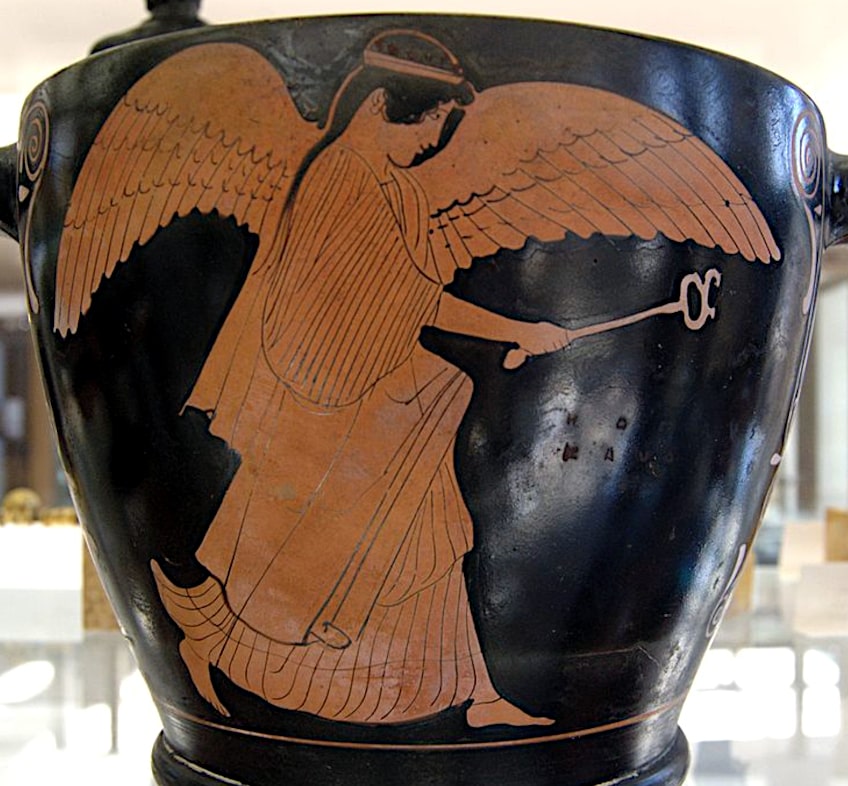 Attic red-figure skyphos with a depiction of Iris by the Penthesilea Painter (middle of the 5th Century BCE); BnF Museum, Public domain, via Wikimedia Commons
Attic red-figure skyphos with a depiction of Iris by the Penthesilea Painter (middle of the 5th Century BCE); BnF Museum, Public domain, via Wikimedia Commons
Iris’s Personality
Iris is recognized for her unflinching dedication to her responsibilities as the gods’ messenger. She works diligently and honestly to ensure that messages get to their destinations effectively and quickly. Her devotion to the celestial world and her duty as a messenger reveals her commitment to her duties.
Her grace is mirrored in her quick movements and the brilliant rainbow arc that signifies her presence.
Iris is also connected to mediation and diplomacy. She serves as a liaison between the celestial beings and the mortals, conveying messages and directives with subtlety and diplomacy. Iris is seen as a mediator due to facilitating dialogue and understanding between various groups. As a messenger of the gods, she brings messages to humanity that can offer them joy, relief, or crucial information.
Physical Appearance
Iris is said to have a very elegant appearance. She is generally depicted as tall and thin, with a dignified demeanor that emphasizes her heavenly role as a god’s messenger. Iris is believed to have a dazzling, luminous face. Her beauty is characterized as mesmerizing, and she emits a radiance and vibrancy. Her bright beauty fits with her affinity for rainbows and the brilliant colors they reveal.
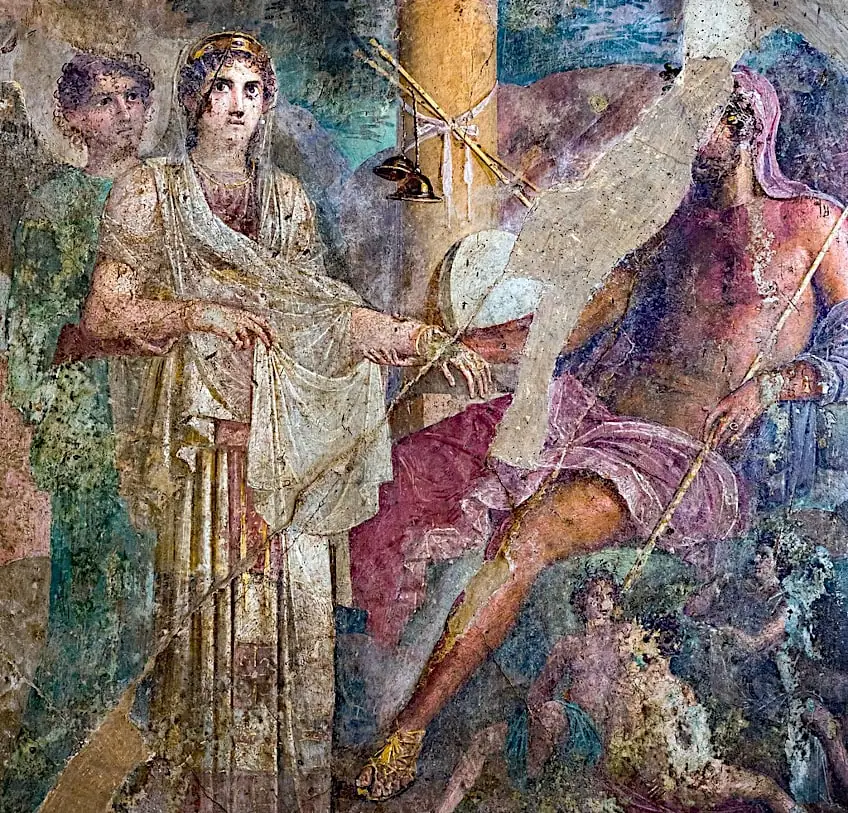 Roman fresco from Pompeii showing Iris (left) assisting Hera and Zeus at their wedding (c. 65 CE); ArchaiOptix, CC BY-SA 4.0, via Wikimedia Commons
Roman fresco from Pompeii showing Iris (left) assisting Hera and Zeus at their wedding (c. 65 CE); ArchaiOptix, CC BY-SA 4.0, via Wikimedia Commons
Iris is often represented in flowing and airy attire reflecting her position as a celestial messenger. The clothes she wears tend to be described as flowing and made of fragile, shimmering materials, which add to her beautiful and otherworldly image.
In some sources, she is represented wearing a multicolored coat with which she creates the rainbows she uses to move from place to place.
Iris Goddess Symbols
The rainbow is probably the most well-known symbol linked with Iris. As the embodiment of the rainbow, the Greek goddess is inextricably linked to this natural event. The rainbow signifies her existence and acts as a connection between the human and celestial realms. It illustrates how she serves as a messenger between the celestial and terrestrial realms, bringing heavenly messages and instructions. The caduceus, a staff twisted with two snakes, is another popular Iris symbol.
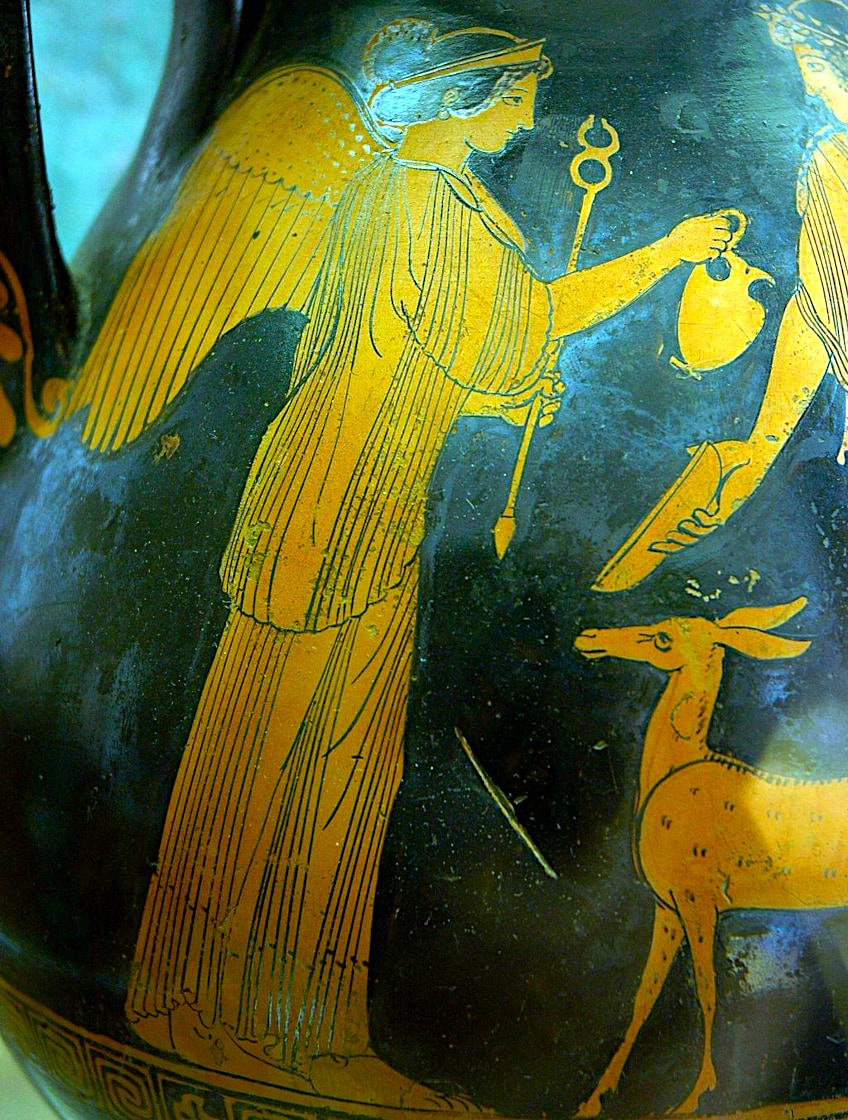 Attic red-figure pelike showing Iris with her symbols of a pitcher and caduceus (middle of the 5th Century BCE); BnF Museum, Public domain, via Wikimedia Commons
Attic red-figure pelike showing Iris with her symbols of a pitcher and caduceus (middle of the 5th Century BCE); BnF Museum, Public domain, via Wikimedia Commons
It indicates her influence as a messenger and is a prevalent attribute of Greek heralds and messengers. The caduceus is considered to be a symbol of diplomacy, communication, and message delivery. Iris’s wings represent her speed in traveling large distances as she transports messages across realms. Iris is also often portrayed with a pitcher of water in her hand, in which she was carried water from the River Styx.
While not as common as the other symbols, Iris can also be associated with flowers. She is seen in several images surrounded by or holding flowers, notably irises. This connection emphasizes the brilliant colors she symbolizes as the personification of rainbows.
Iris’ Greek Mythology
As we mentioned earlier, there are no myths that feature Iris as the main character of any Greek myths. However, she does feature in the myths of other deities, where her role as a messenger was significant enough to mention here. Let’s find out how Iris impacted the various myths mentioned in The Iliad and The Odyssey, as well as other Greek myths.
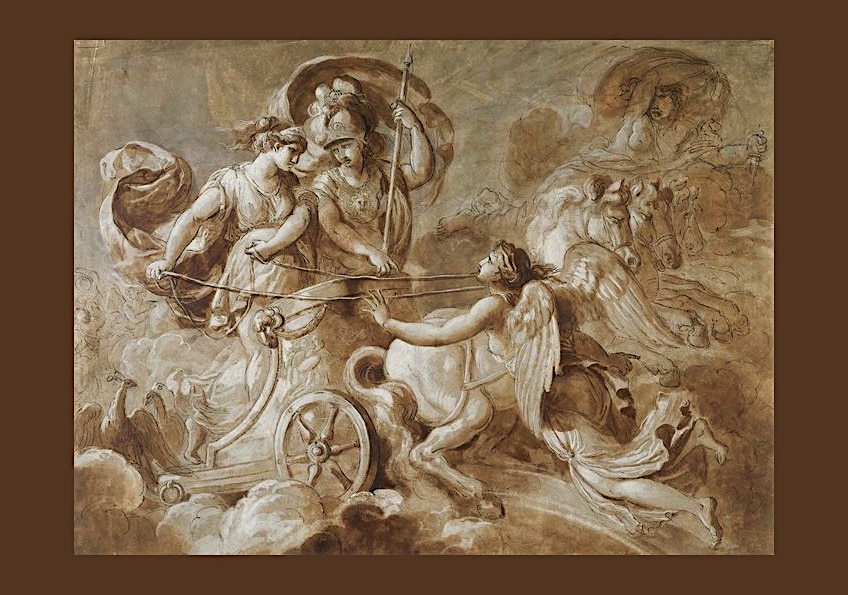 Hera, Athena, and Iris in the Trojan War attributed to Jacques Réattu (18th Century); Jacques Réattu, Public domain, via Wikimedia Commons
Hera, Athena, and Iris in the Trojan War attributed to Jacques Réattu (18th Century); Jacques Réattu, Public domain, via Wikimedia Commons
Iris in The Odyssey
In a particular chapter of the myth, Zeus sent Iris to convey a message to Odysseus’ wife, Penelope. The message’s purpose was to ease her anxieties, assuring her that her son Telemachus would return safely from his expedition to find out what happened to his father. Iris disguises herself as Penelope’s sister, and her outward appearance and message give Penelope hope during Odysseus’ extended absence. In another verse, the poet portrays Helen, Menelaus’ wife, invoking Iris and requesting that she expedite Telemachus’ trip home.
In another scene, Athena disguised as Mentor, encouraged Telemachus by invoking Iris and promising that she would see to it that his plan to deal with the suitors and reclaim control of his home was carried out.
Athena changed Odysseus into his actual form at the end of The Odyssey, following the last conflict between Odysseus and the suitors, she sent the Greek goddess Iris to carry a message to the relatives of the murdered suitors. Iris informed them of their deaths and advised them not to try to exact vengeance, stressing that the suitors’ behavior contributed to their fate.
Iris in The Iliad
Iris appears as a messenger of the gods on various occasions in The Iliad. In one part of the poem, Hera sent Iris to notify Poseidon that the gods could no longer interfere in the Trojan War. She conveyed the message, emphasizing Zeus’ demand and pleading with Poseidon to leave the battlefield. Zeus summoned Iris to convey a message to the Trojan prince, Hector, in another verse. She also carried messages from Zeus to the Trojan prince Hector, who the king of the gods manipulated to keep his promise to the goddess Thetis that the Greeks would lose against the Trojans, until her son Achilles returned to the battlefield.
 Jupiter (Zeus) sends Iris to Hector by Bernard Picart (1710); Rijksmuseum, CC0, via Wikimedia Commons
Jupiter (Zeus) sends Iris to Hector by Bernard Picart (1710); Rijksmuseum, CC0, via Wikimedia Commons
She informed Hector about the approaching danger and advised him to flee. Iris descended from Olympus to notify Achilles of his father’s request for him to return to combat in this scene. She informed Achilles that Zeus had granted him victory over the Trojans and encouraged him to make amends with the Greek commander-in-chief, Agamemnon.
As Achilles battled Hector following his companion Patroclus’ death, Apollo sent Iris to defend Hector from Achilles’ unrelenting pursuit. Iris cloaked Hector in a protecting mist, giving him a brief reprieve from Achilles’ fury.
Other Messenger Myths
Following Hades’ abduction of her daughter Persephone, Demeter retired to her temple in Eleusis and turned the soil barren, triggering a catastrophic famine that killed off mankind, and offerings to the gods ended. Zeus subsequently sent Iris to Demeter, inviting her to join the other deities and ease her curse, but Demeter was unconvinced because her daughter had not returned.
In another story, after Leto and her children begged Zeus to release Prometheus from his misery, Zeus yielded and sent the Greek goddess Iris to command Heracles to free the wretched Prometheus.
Hera ordered Iris to deliver her commands to Hypnos after Ceyx died in a shipwreck. Iris rushed to his cave and told him that Hera was hoping for Ceyx’s wife, Alcyone, to be notified of her loved one’s death through her dreams. Iris departed soon after issuing Hera’s instruction, not wanting to stay near Morpheus, the god of sleep for too long, as his energies overtook her and made her feel disoriented and tired.
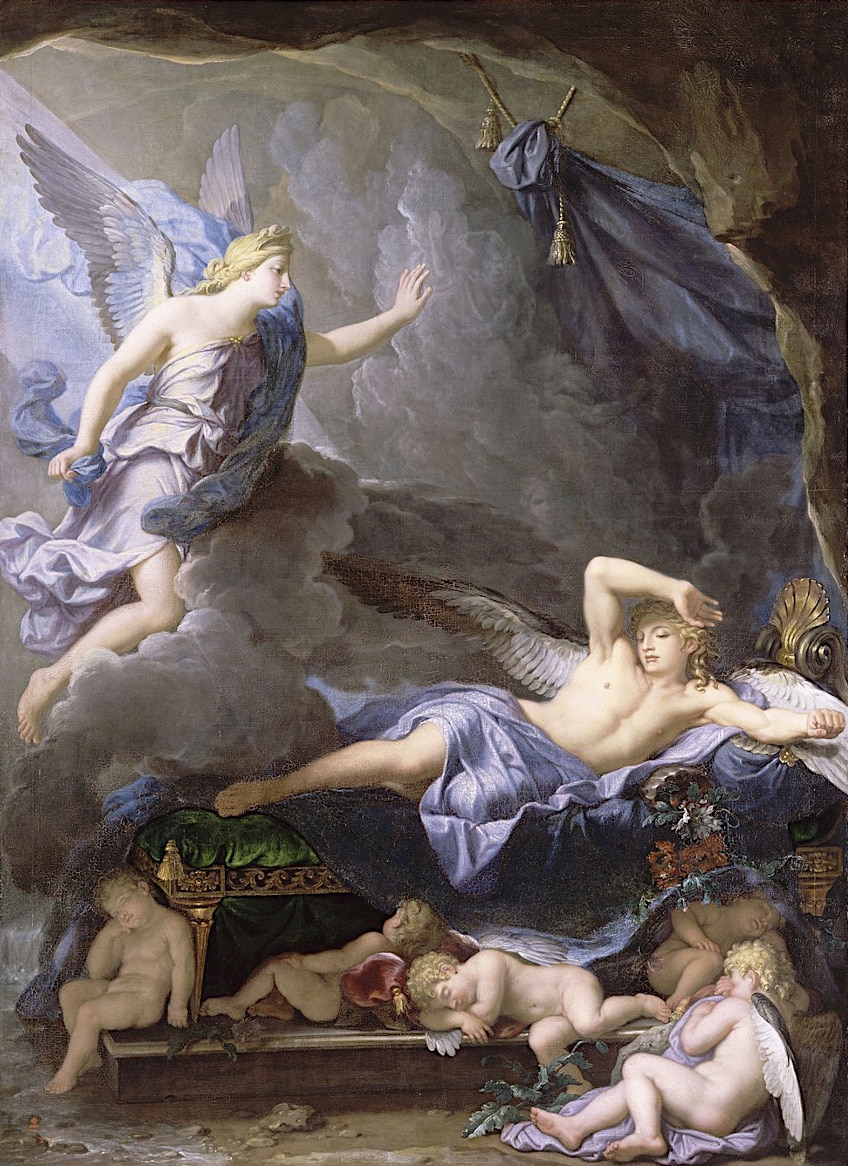 Morpheus Awakens as Iris Draws Near by René-Antoine Houasse (1690); René-Antoine Houasse, Public domain, via Wikimedia Commons
Morpheus Awakens as Iris Draws Near by René-Antoine Houasse (1690); René-Antoine Houasse, Public domain, via Wikimedia Commons
In Aristophanes’ comedy, The Birds, these creatures intended to overthrow the Olympian gods by constructing a metropolis for birds in the sky. The gods sent Iris to confront them, but she was mocked, abused, and threatened with rape by the avian commander named Pisetaerus. Iris was perplexed that Pisetearus was unaware of the gods and that she was counted among them. Pisetaerus then informed Iris that the birds had become gods, idols to whom humans had to sacrifice. Iris rebuked Pisetaerus for his vile language and fled, informing him that Zeus, whom she referred to as her father, was going to deal with him and make him suffer.
Iris appeared multiple times in Virgil’s Aeneid, generally as Juno’s emissary.
In Book 4, Juno assigned her to remove a lock of hair from Queen Dido’s head so that she might pass away and join Hades. In Book 5, Iris, disguised as a Trojan woman, incited the other Trojan women to set alight four of Aeneas’ ships, preventing them from departing Sicily. According to Ovid, the Roman poet, after Romulus became known as the deity Quirinus, his wife Hersillia begged the gods to grant her immortality as well, so she might be with her husband again. Juno heard her appeal and sent Iris to her. Iris converted Hersillia into an eternal goddess with the touch of a single finger. Hersillia went to Mount Olympus, where she became a Horae and was granted eternal life with her husband.
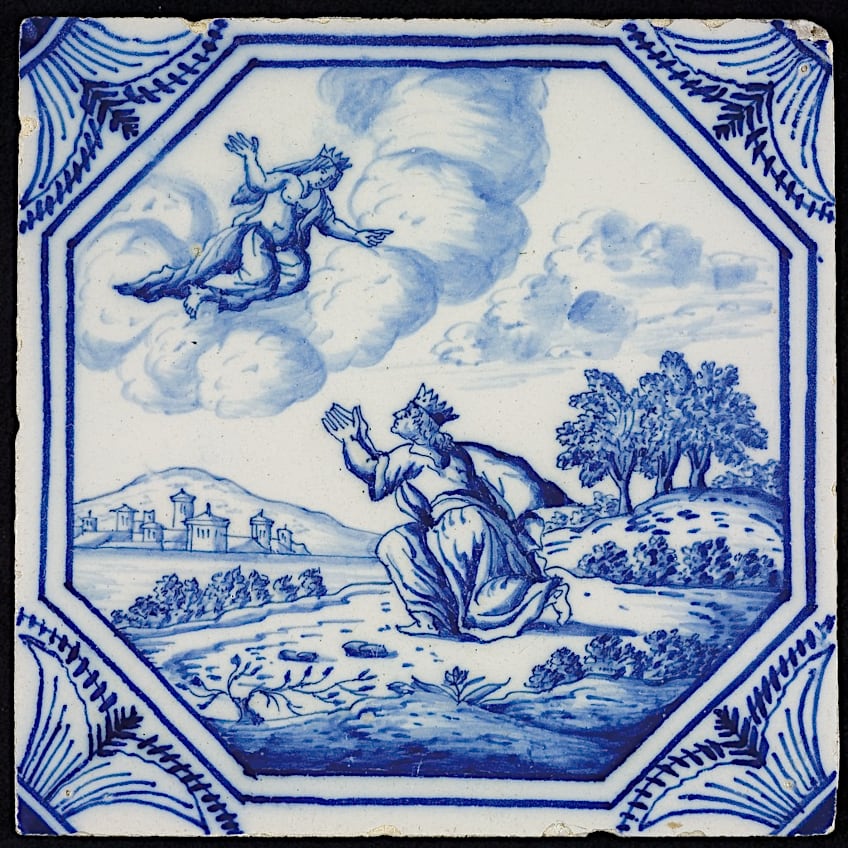 Dutch tile with a depiction of Iris and Hersillia (1740-1780); atelier Aalmis, CC BY-SA 3.0, via Wikimedia Commons
Dutch tile with a depiction of Iris and Hersillia (1740-1780); atelier Aalmis, CC BY-SA 3.0, via Wikimedia Commons
Iris and Leto
All of the Greek Olympian goddesses were there when Leto was in labor before giving birth to her twin twins Artemis and Apollo, with the exception of the goddess of childbirth, Eileithyia, and Hera.
On day nine of her labor, Leto instructed Iris, the goddess of the rainbow, to offer bribes to Eileithyia and beg for her assistance in giving birth to her twins without informing Hera.
On Hera’s commands, Ares and Iris ordered that all cities and other places avoid the pregnant Leto and deny her sanctuary where she might give birth to her twins. Iris returned to Hera to notify her that Leto had been granted the right to give birth on the island of Delos owing to Asteria’s violation of Hera’s rules, and she took her position beside Hera.
 Drawing of a relief depicting Iris, Apollo, Artemis, and Leto by Johann Jakob Horner (1828); Johann Jakob Horner, Public domain, via Wikimedia Commons
Drawing of a relief depicting Iris, Apollo, Artemis, and Leto by Johann Jakob Horner (1828); Johann Jakob Horner, Public domain, via Wikimedia Commons
Iris and the Satyrs
In a lesser-known story, the Greek goddess Iris came dangerously close to being sexually assaulted by the Satyrs after disrupting their devotion to Dionysus, possibly at Hera’s request. About 15 black-and-red-figure vase paintings from the 5th century BCE portray satyrs either threateningly approaching or seizing her when she tried to tamper with the sacrifice.
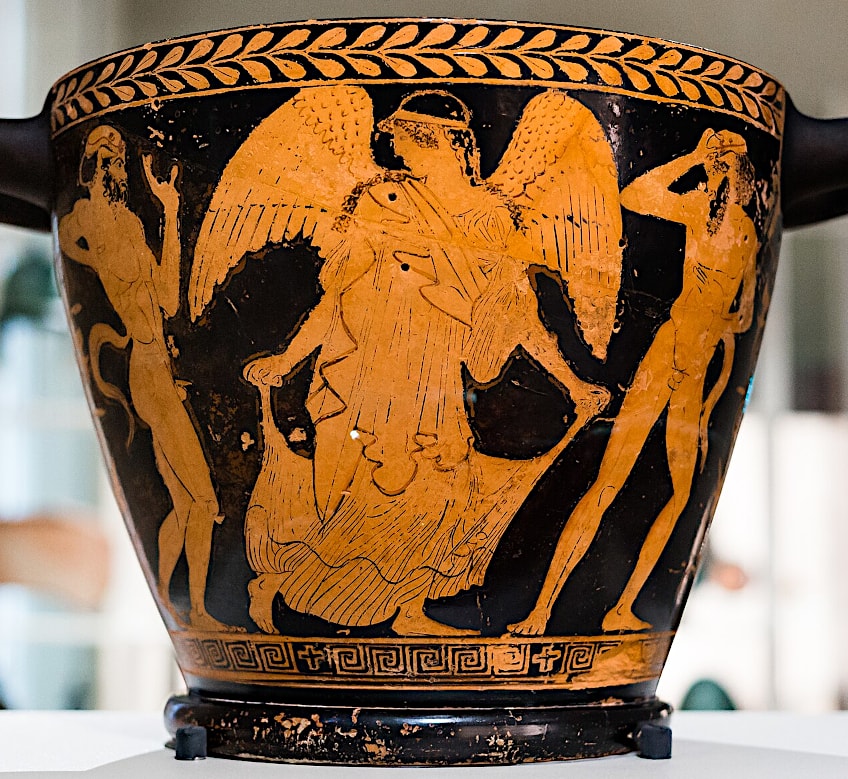 Attic red-figure skyphos with a depiction of Iris being attacked by satyrs (c. 470-450 BCE); ArchaiOptix, CC BY-SA 4.0, via Wikimedia Commons
Attic red-figure skyphos with a depiction of Iris being attacked by satyrs (c. 470-450 BCE); ArchaiOptix, CC BY-SA 4.0, via Wikimedia Commons
On another cup, Iris is portrayed as being beaten by satyrs, who appear to be attempting to stop her from taking sacrificial meat from Dionysus’ altar, who also appears in the scene. The satyrs are portrayed fighting Hera, who stands between Heracles and Hermes on the other side of the cup.
Worship
Unlike Hermes, the other major Greek messenger deity, Iris, the goddess of the rainbow played a minor role in ancient Greek mythology and was rarely worshiped. There are no documented Iris shrines, temples, or sanctuaries, nor are there festivals in her honor.
While she appears often in bas-reliefs and on vases, few sculptures of Iris are known to have been created during antiquity.
She was, nevertheless, sculpted on the west pediment of the Parthenon in Athens. Iris appears to have been the focus of some minor veneration, but the sole evidence of her cult preserved is a note by Athenaeus that the inhabitants of Delos offered up to Iris basyniae, a type of cake made of wheat flour, honey, and suet boiled together.
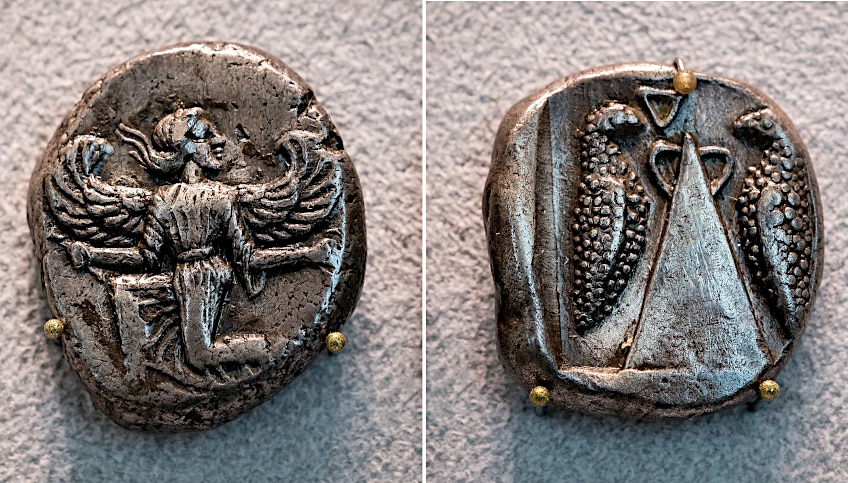 Examples of 5th Century silver coins from Kaunos with depictions of Iris on one side; ArchaiOptix, CC BY-SA 4.0, via Wikimedia Commons, and an aniconic conical cult statue flanked by birds on the other; ArchaiOptix, CC BY-SA 4.0, via Wikimedia Commons
Examples of 5th Century silver coins from Kaunos with depictions of Iris on one side; ArchaiOptix, CC BY-SA 4.0, via Wikimedia Commons, and an aniconic conical cult statue flanked by birds on the other; ArchaiOptix, CC BY-SA 4.0, via Wikimedia Commons
Iris Through the Ages
In Roman mythology, Iris, referred to as “Iris” in Latin, remained the gods’ messenger. She often appeared in Roman art and was connected with communication, rainbows, and heavenly messengers. Iris was depicted in sculptures and paintings during the Renaissance and Baroque periods, generally as a beautiful and ethereal figure, representing her association with rainbows and communicating.
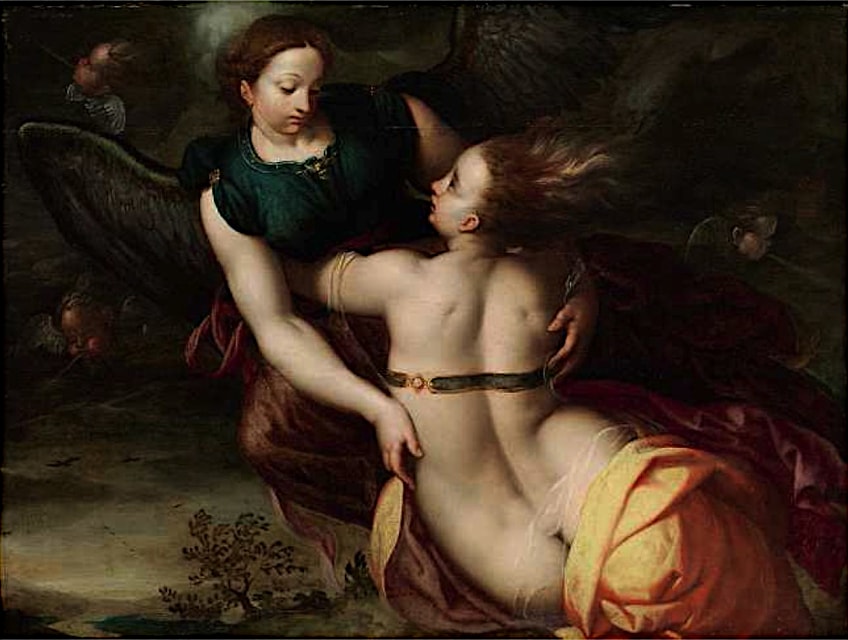 The Goddess Iris Saves Dido with the Help of Favorable Winds from the Sea by Jacob de Backer (between 1560 and 1590); Jacob de Backer, Public domain, via Wikimedia Commons
The Goddess Iris Saves Dido with the Help of Favorable Winds from the Sea by Jacob de Backer (between 1560 and 1590); Jacob de Backer, Public domain, via Wikimedia Commons
Following the Greek period, Iris appeared in a variety of literary works. In the Divine Comedy, for instance, the Greek goddess Iris emerges in the Paradiso as a representation of divine communication and the unity of both earth and heaven. Iris was known as a rainbow symbol, spanning the gap between the divine realm and the realm of mortals. Rainbows were thought to be ethereal and mystical events, typically connected with divine messages or as a link between worlds.
Iris is sometimes mentioned or included as a character in contemporary literature. She is typically represented as a benign entity, providing messages or helping individuals on their adventures.
Lessons of the Goddess of the Rainbow
The Greek goddess Iris is widely acknowledged as the gods’ messenger, highlighting the necessity of successful mediation and communication. Her position emphasizes the need for open and honest communication in settling issues, communicating essential messages, and sustaining happy relationships. Rainbows, which represent a link between the heavenly and everyday realms, are typically associated with Iris. This acts as a reminder of how multiple realms or parts of life are interrelated. It teaches us to understand the interaction of the heavenly and the material, as well as to develop ways to bridge the gaps between diverse points of view and experiences.
 The Iris by an unknown artist (1904); See page for author, Public domain, via Wikimedia Commons
The Iris by an unknown artist (1904); See page for author, Public domain, via Wikimedia Commons
The Greek goddess Iris, as a heavenly messenger, dutifully carries out the gods’ directives. Iris’ Greek mythology emphasizes the value of submission to a higher authority or divine will. It implies that doing one’s duty and listening to higher forces can result in favorable outcomes. The relationship of Iris with rainbows represents optimism, beauty, and the fleeting essence of life.
Rainbows serve as a reminder of the transient and cyclical aspects of life, in addition to the possibility of rebirth and advancement.
They also act as a visual reminder to enjoy life’s fleeting moments and to discover beauty even in the face of considerable adversity and challenges. The Greek goddess Iris usually appears as an agent of change and transition. Her presence in mythology often indicates a shift in circumstances or the beginning of a new cycle. This teaches us to accept change with grace and perseverance, cope with shifts, and adjust to new conditions.
As we have learned today, the goddess of the rainbow was also a significant messenger for the gods, serving as the means by which the deities communicated with each other, as well as with the mortals on Earth. Her rainbows are symbolic of the link between gods and mortals. While she may not have necessarily had the extensive mythology that many of the other gods had, she did feature in many of the myths involving both gods and mortals on many occasions. The most important lesson we can learn from Iris’ Greek mythology is that clear and honest communication is always important when conveying one’s messages and instructions to others.
Frequently Asked Questions
What Were Goddess Iris’ Symbols?
As the Greek goddess responsible for communicating messages between the gods and humans, one of her most prominent symbols is the rainbow. Rainbows are believed to connect the heavens and the Earth, and in Iris’ Greek mythology, she would use these rainbows as a way to descend from the realm of the Greek deities to Earth and back. The caduceus is a kind of staff with two intertwining serpents wrapped around it and was another well-known symbol of the goddess. The pitcher is also one of her symbols, and she was known to use it to fetch water from the sacred River Styx, which flowed into the underworld.
What Was Iris’s Role in Greek Mythology?
The Greek goddess Iris was most well-known for being the Greek gods’ messenger. In many myths, she was called upon to deliver instructions or messages to either gods or mortals. She was most often sent on errands by the Greek goddess Hera. She was also sent by Leto when she was giving birth to Apollo and Artemis to go and bribe the goddess of childbirth behind Hera’s back. The most obvious message we can take away from the Greek goddess Iris’ mythology is that clear communication is essential in situations relating to the heart.

I am deeply passionate about history and am constantly fascinated by the rich and complex stories of the past. As the editor-in-chief of learning-history.com, I have the opportunity to share this passion with a wide audience through the creation and distribution of engaging and informative content about historical events, persons, and cultures. Whether it’s through writing articles and blog posts or creating videos or podcasts, I strive to bring the past to life in a way that is both accurate and enjoyable. My expertise in history, combined with my strong writing and communication skills, allows me to effectively communicate complex historical concepts and make them accessible and interesting to a wide range of readers. I am truly grateful for the opportunity to share my love of history with others through my work on learning-history.com.


